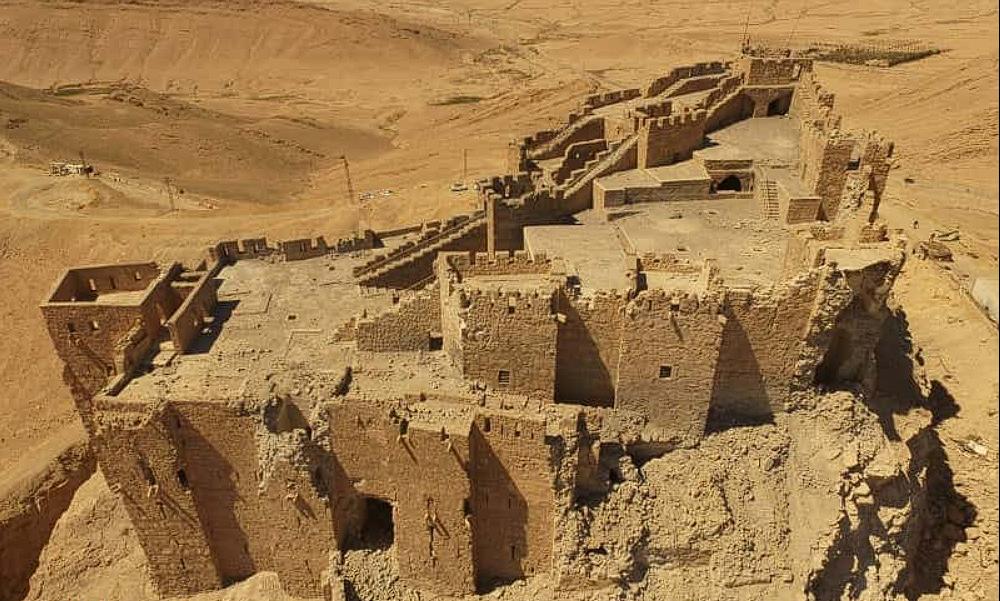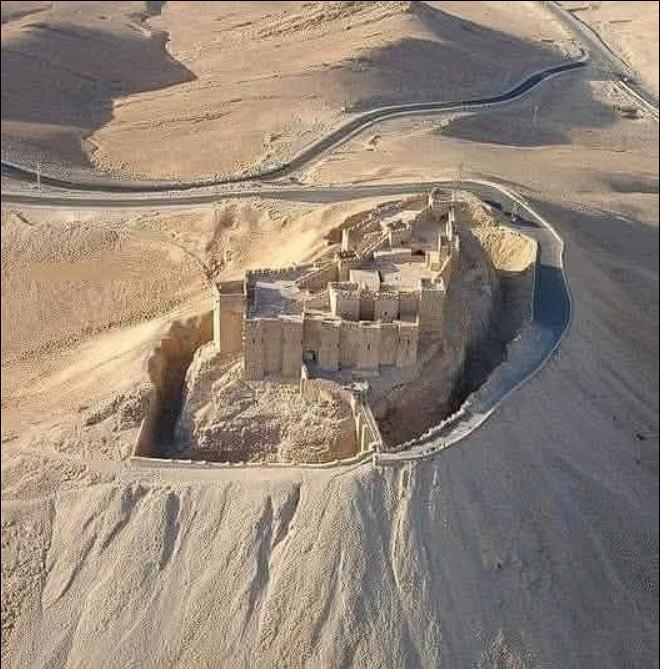Palmyra Castle, also known as Fakhr-al-Din al-Ma’ani Castle, stands as a striking testament to Syria’s rich history and strategic importance. Perched atop a hill in the Homs province, this fortress, built by the Mamluks in the 13th century, offers a commanding view of the ancient city of Palmyra and the vital trade routes that once traversed the region.
The Strategic Importance of Palmyra Castle
Palmyra Castle’s strategic location and formidable defenses made it a crucial stronghold throughout history, witnessing the rise and fall of empires.
Mamluk Origins and Strategic Position
Built by the Mamluks in the 13th century, the castle’s strategic position was designed to safeguard Palmyra and its trade routes.

- 13th Century Construction:
- The castle’s construction during the Mamluk period highlights its importance as a defensive structure during a time of regional conflict and trade expansion.
- It was built in the 13th century.
- Overseeing Palmyra:
- Its location allowed it to oversee the ancient city of Palmyra, a vital trading hub, ensuring the security of the city and its inhabitants.
- It overlooked Palmyra.
- Trade Route Protection:
- The castle’s position was crucial for safeguarding vital trade routes that crossed the desert, protecting merchants and caravans from potential threats.
- It protected trade routes.
Formidable Defenses
The castle’s thick stone walls, fortified towers, and protective moat made it a formidable defense against invaders for centuries.
- Thick Stone Walls:
- The thick stone walls provided a strong barrier against attacks, ensuring the castle’s resilience in times of conflict.
- It had thick stone walls.
- Fortified Towers:
- The fortified towers offered strategic vantage points for defenders, allowing them to monitor the surrounding area and repel attackers.
- It had fortified towers.
- Protective Moat:
- The protective moat added an extra layer of defense, making it difficult for attackers to breach the castle’s walls.
- It had a protective moat.
Historical Significance
Palmyra Castle’s strategic importance is underscored by its role in various historical periods, witnessing countless conflicts and shifting powers.
- Mamluk Period:
- The castle’s origins in the Mamluk period highlight its significance during a time of regional power struggles and trade expansion.
- It was important during the Mamluk period.
- Ottoman Reinforcements:
- Later reinforcements under Ottoman rule further enhanced the castle’s defensive capabilities, ensuring its continued importance as a stronghold.
- It was reinforced by the Ottomans.
- Witness to Conflicts:
- The castle has witnessed countless conflicts and shifting powers, serving as a silent observer of Syria’s turbulent history.
- It witnessed conflicts.
Architectural and Cultural Heritage
Palmyra Castle’s architectural features and cultural significance make it an enduring symbol of Syria’s heritage.
Architectural Features
The castle’s architectural features reflect its military purpose and the craftsmanship of its builders.

- Stone Construction:
- The use of stone in its construction highlights the durability and strength of the castle, ensuring its longevity.
- It was built with stone.
- Tower Design:
- The design of the towers, with their strategic placement and defensive features, showcases the architectural ingenuity of the Mamluks.
- The towers were well-designed.
- Moat and Walls:
- The integration of a moat and thick walls demonstrates the castle’s comprehensive defense system, making it a formidable stronghold.
- It had a moat and thick walls.
Fakhr-al-Din al-Ma’ani Connection
Though named after the Druze emir Fakhr-al-Din al-Ma’ani, the castle’s origins trace back to the Mamluk period, with later reinforcements under Ottoman rule.
- Druze Emir’s Influence:
- Fakhr-al-Din al-Ma’ani’s control of the region in the 17th century led to the castle being named after him, highlighting his influence.
- It was named after a Druze Emir.
- Mamluk Foundations:
- The castle’s foundations were laid by the Mamluks, emphasizing their role in its initial construction and strategic importance.
- It had Mamluk foundations.
- Ottoman Enhancements:
- Ottoman enhancements to the castle further solidified its defensive capabilities, reflecting the shifting powers in the region.
- It was enhanced by the Ottomans.
Enduring Symbol
Despite damage from recent conflicts, Palmyra Castle remains an enduring symbol of Syria’s architectural and cultural heritage.
- Cultural Heritage:
- The castle’s preservation is crucial for preserving Syria’s cultural heritage, reflecting its rich history and architectural traditions.
- It is cultural heritage.
- Architectural Legacy:
- Its architectural legacy serves as a reminder of the craftsmanship and engineering skills of past civilizations.
- It has architectural legacy.
- Symbol of Resilience:
- Despite damage, the castle stands as a symbol of resilience, reflecting the enduring spirit of the Syrian people.
- It is a symbol of resilience.
Panoramic Views and Visitor Experience
Visitors to Palmyra Castle are rewarded with breathtaking panoramic views of Palmyra, a city that once stood at the crossroads of civilizations.
Breathtaking Panoramic Views
The climb to the castle’s ruins offers visitors breathtaking panoramic views of Palmyra and the surrounding landscape.
- Overlooking Ancient City:
- The castle’s elevated position provides a stunning view of the ancient city of Palmyra, allowing visitors to appreciate its historical significance.
- It overlooks the ancient city.
- Desert Landscape:
- The panoramic views of the desert landscape highlight the castle’s strategic position and the vastness of the region.
- It has desert landscape views.
- Photographic Opportunities:
- The views offer exceptional photographic opportunities, capturing the beauty and historical significance of Palmyra and its surroundings.
- It has photographic opportunities.
Historical Significance of Palmyra
Palmyra’s historical significance as a crossroads of civilizations adds to the allure of the castle and its surroundings.
- Crossroads of Civilizations:
- Palmyra’s role as a crossroads of civilizations highlights its importance in ancient trade and cultural exchange.
- It was a crossroads of civilizations.
- Ancient Trade Routes:
- The castle’s proximity to ancient trade routes underscores its strategic importance and the region’s historical significance.
- It was near ancient trade routes.
- Cultural Exchange:
- The city’s history of cultural exchange adds depth to the visitor experience, providing context for the castle’s role in the region’s past.
- It was a site of cultural exchange.
Visitor Experience
Visiting Palmyra Castle offers a unique opportunity to connect with Syria’s rich history and architectural heritage.
- Climbing to Ruins:
- The climb to the castle’s ruins provides a sense of adventure and discovery, enhancing the visitor experience.
- Visitors can climb to the ruins.
- Connecting with History:
- Walking through the castle’s ruins allows visitors to connect with the past, imagining the lives of those who once lived and defended it.
- Visitors can connect with history.
- Cultural Immersion:
- Visiting the castle offers a cultural immersion experience, providing insights into Syria’s architectural and historical legacy.
- Visitors can immerse in culture.
Palmyra Castle, with its strategic importance, architectural features, and breathtaking panoramic views, stands as an enduring symbol of Syria’s rich history and cultural heritage. Its ruins offer a powerful reminder of the region’s past and its significance as a crossroads of civilizations.

CÁC TIN KHÁC
Mary Walton: The Forgotten Inventor Who Helped Clean Up America’s Cities
Tomb of Queen Nefertari in the Valley of the Queens, Egypt
Discover the Hypostyle Hall of the Temple of Hathor at Dendera
Venus de Losange: Unveiling the Mystery of a 20,000-Year-Old Paleolithic Icon